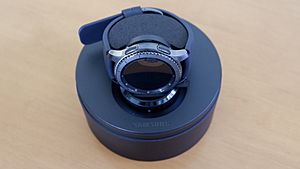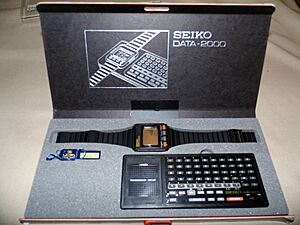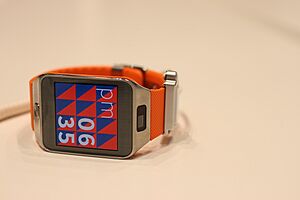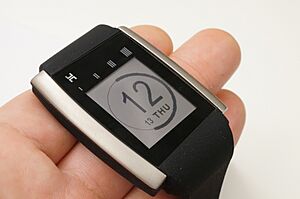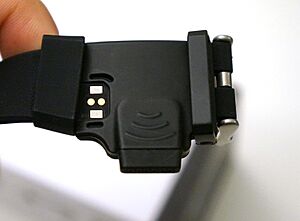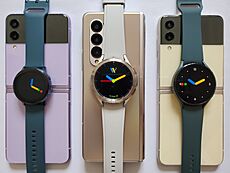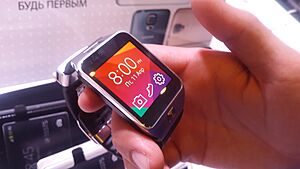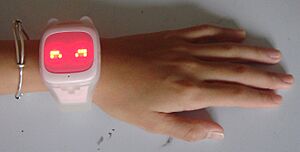Smartwatch facts for kids
A smartwatch is like a tiny computer you wear on your wrist, shaped like a regular watch. Most smartwatches today have a touchscreen and use mobile apps to do cool things. These apps often connect to your smartphone to work.
Older smartwatches could do simple tasks like calculating numbers, showing the time, translating words, or playing games. Newer models are much more advanced. They can do many things a smartphone can, like running apps, connecting to Bluetooth and Wi-Fi, and playing music or FM radio. Some fancy smartwatches even let you make and receive phone calls without your phone!
Inside, most smartwatches have a bright LCD or OLED screen. They are powered by a rechargeable battery. Many also have GPS to help you find your way, and sensors like thermometers, accelerometers (to detect movement), and heart rate monitors. Some smartwatches are also activity trackers, counting your steps or checking your heart. Their software can include maps, health apps, calendars, and different watch faces.
Contents
History of Smartwatches
Early Smartwatch Ideas
The very first digital watch was called the Pulsar, made in 1972. Later, in 1982, a Pulsar watch came out that could store 24 numbers. This might have been the first watch where you could save your own information.
In the 1980s, as personal computers became popular, Seiko started making watches that were like small computers. Their Data 2000 watch, released in 1984, could store 2000 characters. It even came with a separate keyboard to type in data, which wirelessly connected to the watch.
Seiko continued to make more advanced watches. The RC-1000 Wrist Terminal from 1984 was the first Seiko watch that could connect to a computer. It had 2 KB of storage and could link up with many popular computers of that time, like Apple II and IBM PC.
During the 1980s, Casio also became famous for its "computer watches" and calculator watches. They even made fun "game watches." By the end of the 1980s, pager watches, which could receive messages, also became more common.
Smartwatches in the 1990s
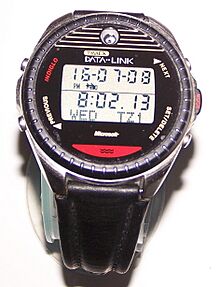
The Timex Datalink, released in 1994, was special because it could get information wirelessly from a computer. You could send appointments and contacts to the watch using flashing light patterns from your computer screen.
In 1998, a person named Steve Mann created the world's first Linux wristwatch. This was a big step for wearable computers.
Also in 1998, Seiko launched the Ruputer in Japan. This watch could show graphics and run apps made by other people. It is sometimes called the first true smartwatch. In 1999, Samsung released the SPH-WP10, which was the world's first watch that could also make phone calls.
Smartwatches in the 2000s
In 2000, IBM showed off a test version of the WatchPad, a wristwatch that ran the Linux operating system. It had 8 MB of memory and later got upgrades like a fingerprint sensor. IBM worked with Citizen Watch Co. to develop it further.
In 2003, Fossil released the Wrist PDA, a watch that ran the Palm OS system. It had a tiny screen and came with a stylus to help you use it. Even though it was seen as amazing, it was also quite heavy.
Microsoft also joined in, releasing its SPOT smartwatch in 2004. SPOT stood for "Smart Personal Objects Technology." These watches could show information like weather, news, and stock prices using FM radio waves. You needed a yearly subscription to get this information.
Later in the 2000s, Sony Ericsson and Fossil teamed up to make the MBW-100, the first watch that connected to phones using Bluetooth. In 2009, the "Burg" watch was launched. It was the first smartwatch that could work on its own with its own SIM card, without needing a smartphone.
Smartwatches in the 2010s
The 2010s saw a big boom in smartwatches. Sony Ericsson released the Sony Ericsson LiveView, which was a small screen that connected to an Android phone.
A company called Pebble launched a smartwatch through Kickstarter in 2012. It raised over $10 million, which was a huge amount at the time. The Pebble watch had a black and white screen, a vibrating motor, and could connect to both Android and iOS phones using Bluetooth. It was also water resistant, so you could swim with it.
In 2013, many experts thought it would be the "year of the smartwatch." Companies like Acer, Apple, Google, LG, Microsoft, Samsung, and Sony were all working on their own smartwatches. One challenge was making batteries last longer, as most watches only lasted a few days.
In September 2013, new smartwatches like the Samsung Galaxy Gear, Sony SmartWatch 2, and Qualcomm Toq were launched. The HOT Watch, funded through Kickstarter, allowed users to make calls directly from the watch strap.
In April 2014, the Samsung Gear 2 came out, which was one of the few smartwatches with a built-in digital camera. At the 2014 Consumer Electronics Show, many new smartwatches were shown, leading some to call it a "wrist revolution." Google I/O in June 2014 introduced the Android Wear platform, and the LG G Watch and Samsung Gear Live were released.
Later in 2014, Samsung launched the Gear S, which had a curved screen and a built-in 3G modem, meaning it could connect to the internet on its own. Sony also released its third smartwatch, the Sony Smartwatch 3, running Android Wear.
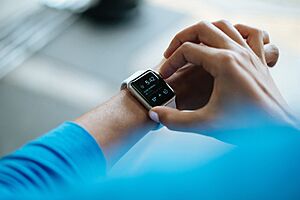
On September 9, 2014, Apple announced its first smartwatch, the Apple Watch, which started shipping in April 2015. It was designed to compete with traditional watches, not just other smartwatches. The screen only turns on when you lift your wrist or touch it. In October 2014, Microsoft released the Microsoft Band, a smart fitness tracker.
In October 2015, Samsung unveiled the Samsung Gear S2, which had a cool rotating ring around the screen for easy use. It was also water resistant. At the 2016 Consumer Electronics Show, Razer released the Nabu Watch, which had two screens. Luxury watchmaker TAG Heuer also released its TAG Heuer Connected smartwatch.
In August 2016, Samsung introduced the Samsung Gear S3 with better features. In 2017, Apple released the Apple Watch Series 3, which could make phone calls and send messages using its own cellular connection, without needing a nearby smartphone.
In 2018, Samsung launched the Samsung Galaxy Watch series. Apple also redesigned its Apple Watch Series 4, giving it a larger screen and an EKG feature to check for unusual heart activity. Qualcomm introduced its Snapdragon 3100 chip, which made smartwatches more power-efficient.
Smartwatches in the 2020s
By 2020, smartwatches were becoming even more helpful for health. The United States Food and Drug Administration approved an Apple Watch app called NightWare. This app helps people with PTSD-related nightmares by vibrating when it senses a nightmare based on heart rate and movement.
As of mid-2025, smartwatches have become very advanced. They have many health-monitoring features and better ways to connect. Newer models, like the Apple Watch Series 10 and Google Pixel Watch 3, can detect sleep apnea and warn you about unusual heart rates. Huawei has even developed technology that can analyze cough patterns to find possible lung problems.
Smartwatch Popularity
Smartwatches became very popular in the 2010s. Today, many people use them as fitness trackers or as helpful "companions" to their smartphones. Experts believe that smartwatch sales will continue to grow a lot in the coming years. Some of the biggest companies making smartwatches include Apple, Fossil Group Inc, Garmin, Google, Huawei, Samsung, and Xiaomi.
What Smartwatches Can Do
Many smartwatches made since 2010 can work completely on their own, without needing a phone. Some are great for sports and have GPS to record your workouts. You can upload this data to a computer to keep track of your activities. Some watches can even show maps and your current location.
"Sport watch" features often include activity trackers. They might have training programs, lap timers, speed displays, and heart rate monitors. Other smartwatches work by connecting to your smartphone, usually with Bluetooth. They can show you calls, SMS messages, emails, calendar invites, and other information from your phone's apps.
LTE Connectivity
Since about 2015, some smartwatches have added LTE support. This means they can connect directly to 3G/4G mobile networks. So, you can make calls and send texts right from your watch, without needing your smartphone nearby.
Safety and Health Concerns
Some very cheap smartwatches sold online have had security problems. Tests found that they might collect too much personal information, store it unsafely, or not let you stop them from collecting data. It's hard to know if your information is safe or if the company might share it. Also, some cheap watches were not accurate at measuring things like heart rate when tested.
In the United Kingdom, a new law was passed in 2022 to make sure smart devices, including smartwatches, meet certain security standards.
A study in 2024 found that some smartwatch straps contain high levels of PFAS chemicals. These chemicals can be harmful and might get into your skin. Researchers suggest using straps made of silicone instead, as they do not contain PFAS.
Social Impact and Fairness
Sometimes, the design of smartwatches can accidentally favor certain groups of people. For example, smartwatches might track health data more accurately for people with lighter skin than for those with darker skin. This happens because many smartwatches use optical sensors with green light to check heart rate. Green light has shorter wavelengths and doesn't go through melanin (the pigment that makes skin darker) as well. This can make heart rate tracking less accurate for people with darker skin.
Another social concern is about data collection and privacy. Smartwatches collect personal health data like how active you are, your heart rate, and sleep patterns. This information is often stored online. There have been times when this data was misused. For example, Fitbit faced a lawsuit in 2011 for selling health data to advertisers without users knowing. Also, when Strava allowed users to share their running routes, it accidentally showed the locations of some military bases around the world.
Smartwatch Operating Systems
Smartwatches use different operating systems, which are like the main software that makes them run.
AsteroidOS
AsteroidOS is an open-source (meaning its code is freely available) replacement software for some Android Wear devices.
Flyme OS
Flyme OS is software based on the Android operating system, made by a company called Meizu.
InfiniTime
InfiniTime is the main software for the PineTime smartwatch. It's a community project that lets you customize watch faces, use a flashlight, stopwatch, alarm, and even play a simple game. It can connect to Android phones and other devices.
HarmonyOS
HarmonyOS is an operating system made by Huawei for their smart devices. Since 2021, it has been used in Huawei Watches.
Sailfish OS
Sailfish OS is another Linux-based operating system that can be used on different devices, including some smartwatches.
Tizen
Tizen is a Linux-based operating system developed for many devices, including smartwatches. Samsung has released several smartwatches, like the Samsung Gear 2 and Samsung Gear S3, that run on Tizen.
watchOS
watchOS is the special operating system made by Apple Inc. just for the Apple Watch.
Wear OS
Wear OS, which used to be called Android Wear, is the smartwatch operating system developed by Google Inc..
Smartwatches for Kids and Seniors
In China, smartwatches have become very popular for schoolchildren since around 2015. They are often advertised as safety devices. These watches are usually colorful and made of plastic. They let children make and receive calls, tell the time, and sometimes even check the air temperature. They typically cost between $100 and $200.
Children's smartwatches are also sold in other countries. Some smartwatches can also help older people or those with disabilities. They can report their location to a caregiver if they fall or get lost.
Smart Strap Technology
A "smart strap" is a special watch strap that has its own sensors built in. These sensors can add extra features to your smartwatch. For example, a smart strap might have a tiny camera, an ECG sensor (to check heart health), or other health measurement tools.
See also
 In Spanish: Reloj inteligente para niños
In Spanish: Reloj inteligente para niños
- Android Wear
- Android
- Artificial neural membrane (smartskin)
- Automatic parking and connected car
- Button cell
- Calculator watch
- Clock face
- E-ink
- GPS watch
- G-Shock
- IP Code
- Key finder
- Open-source computing hardware
- Personal organizer
- Remote shutter
- Rollable display
- Smart band
- Quantified self logging
- Lifelog
- Smartglasses
- Smart keychain (NFC keychain)
- Smartphone
- Wearable computer


